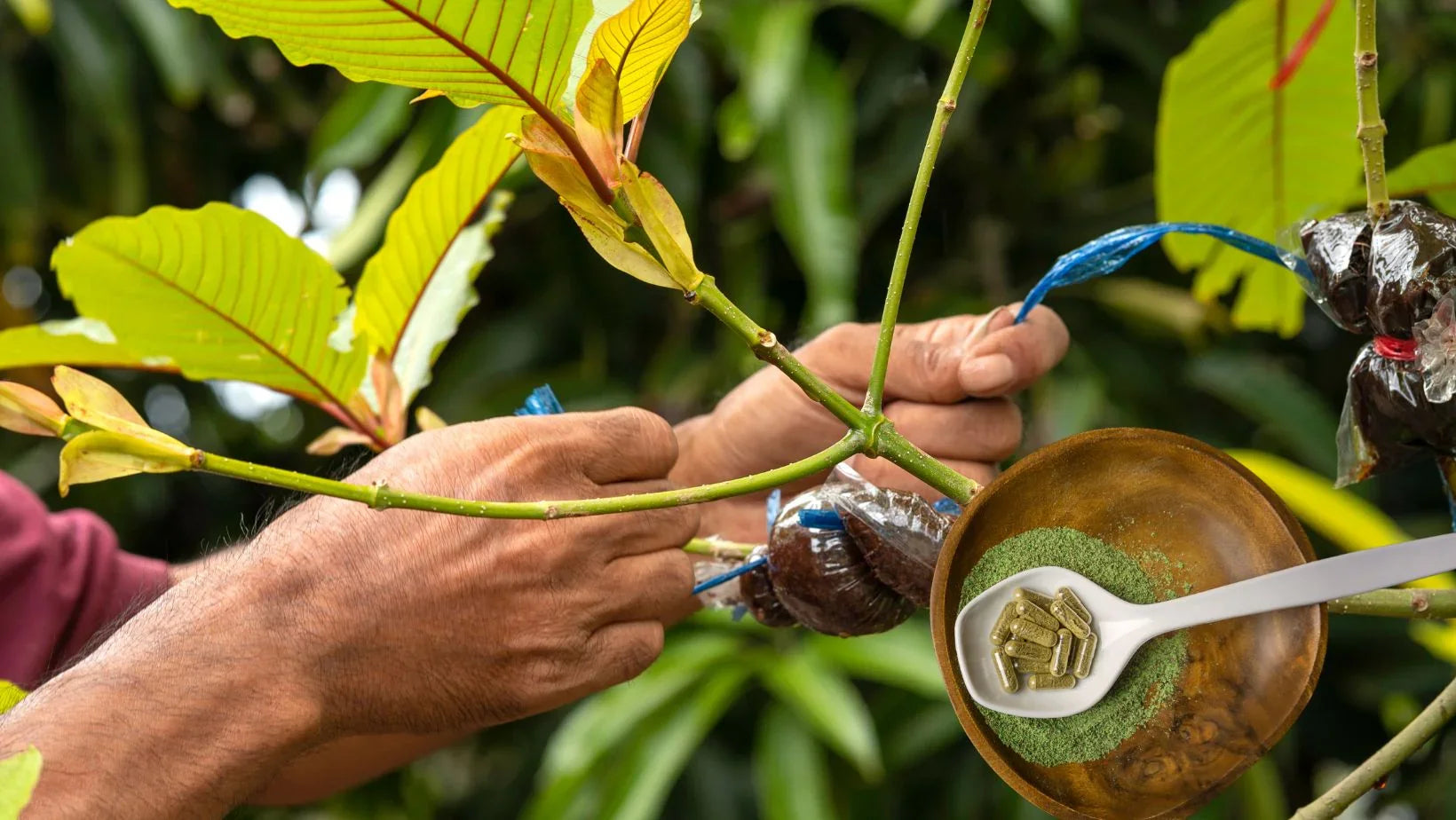
Kratom Alkaloids List: A Detailed Review of Their Properties
Explore the diverse properties of kratom alkaloids with our detailed review, covering effects, benefits, and uses.
Kratom, derived from the leaves of the kratom plant, is known for its rich alkaloid profile, which is responsible for its various effects. This detailed review will explore the different alkaloids found in kratom, their properties, benefits, and how they interact with the body.
We will also compare the potency of these alkaloids and provide user experiences to give a comprehensive understanding of what makes kratom such a unique and versatile herb.
Kratom contains over 40 different alkaloids, with mitragynine and 7-hydroxymitragynine being the most prominent. Alkaloids are naturally occurring compounds that interact with the body’s receptors to produce a range of effects. Here’s an introduction to some of the key alkaloids found in kratom:

The alkaloids present in kratom, particularly mitragynine and 7-hydroxymitragynine, play a pivotal role in the development of tolerance and dependence among users. Mitragynine, as the primary alkaloid, interacts with opioid receptors in the brain, similar to traditional opioids but with varying degrees of affinity and efficacy.
Continuous use of kratom can lead to tolerance, where higher doses are required to achieve the same effects over time. Additionally, the alkaloids influence neuroadaptation processes, contributing to physical dependence and withdrawal symptoms upon cessation of use.
Understanding these alkaloids' pharmacological actions is crucial for assessing the potential risks associated with kratom consumption and developing strategies for harm reduction and safe use practices.
The unique effects of kratom can be attributed to its diverse alkaloid content. Here are some of the top alkaloids found in kratom and their specific effects:
- Effects: Stimulation, energy boost, mood enhancement, mild analgesia.
- Properties: Mitragynine interacts with mu-opioid receptors, providing mild opioid-like effects without the intense euphoria or addiction potential associated with synthetic opioids.
- Common Strains: High in strains like Maeng Da and Thai kratom.
- Effects: Strong analgesia, euphoria, sedation at higher doses.
- Properties: This alkaloid is significantly more potent than mitragynine and is a key contributor to kratom’s pain-relieving properties.
- Common Strains: Found in higher concentrations in red vein strains.
- Effects: Muscle relaxation, anti-inflammatory properties.
- Properties: Works as a muscle relaxant, helping with tension and muscle spasms.
- Common Strains: Present in most kratom strains but not as dominant as mitragynine or 7-hydroxymitragynine.
- Effects: Smooth muscle relaxant.
- Properties: Aids in reducing smooth muscle tension, which can help with gastrointestinal issues.
- Common Strains: Found across various kratom strains.
- Effects: Mild opioid effects, contributes to overall sedation.
- Properties: Acts on opioid receptors, enhancing the sedative and relaxing properties of kratom.
- Common Strains: Present in all kratom strains.
- Effects: Immune system support, antioxidant properties.
- Properties: Stimulates the immune system and provides antioxidant benefits.
- Common Strains: Found in all strains, contributing to kratom’s overall health benefits.
Kratom alkaloids interact with the body primarily through the opioid receptors, but they also influence other systems. Here’s how they work:
The regulation and testing of kratom alkaloids vary significantly across the United States, reflecting the diverse legal landscape and differing approaches to consumer safety. Understanding these state-specific insights is crucial for both consumers and vendors to ensure compliance and safety.
Regulation and Testing: In Illinois, kratom is legal except in Jerseyville. The state has not implemented specific kratom testing regulations. However, consumer safety is a priority, and there is growing support for adopting the Kratom Consumer Protection Act.
Consumer Access: Consumers should look for products from reputable vendors that offer transparency in their testing processes, ensuring the accurate representation of alkaloid levels and the absence of harmful contaminants.
Regulation and Testing: Georgia has passed the Kratom Consumer Protection Act, which mandates rigorous testing for all kratom products. This includes testing for alkaloid content, heavy metals, and other contaminants to ensure consumer safety and product quality.
Consumer Access: With these regulations in place, Georgians can confidently purchase kratom, knowing that the products meet stringent safety standards. Vendors are required to provide lab results, making it easier for consumers to verify product quality.
Regulation and Testing: Kratom is legal in Colorado, with no specific state regulations for alkaloid testing. However, the state’s emphasis on consumer safety and wellness encourages vendors to adopt best practices for product testing.
Consumer Access: Colorado consumers are advised to seek out kratom products from vendors that conduct thorough testing and provide detailed lab reports, ensuring the products are safe and accurately labeled.
Regulation and Testing: Kentucky allows the sale of kratom without specific state-imposed testing requirements. Despite the absence of formal regulations, there is a push within the industry to adopt voluntary testing standards to ensure consumer safety.
Consumer Access: To ensure safe consumption, Kentucky residents should purchase kratom from reputable vendors that offer transparency through lab-tested products, confirming the alkaloid content and absence of contaminants.
Regulation and Testing: Texas has legalized kratom without specific state-mandated testing requirements. Despite the lack of formal regulations, many vendors in Texas adhere to industry standards for testing to maintain consumer trust and product integrity.
Consumer Access: Texans can access a wide range of kratom products. To ensure safety, consumers are encouraged to purchase from vendors who provide detailed lab reports on alkaloid content and contaminant testing.
The diverse alkaloid profile of kratom provides a wide range of benefits and uses:
- Pain Relief: Alkaloids like 7-hydroxymitragynine provide potent analgesic effects, making kratom useful for managing chronic pain.
- Energy and Focus: Mitragynine and other stimulating alkaloids enhance energy levels and improve focus, making kratom a popular choice for productivity.
- Mood Enhancement: By interacting with serotonin and dopamine receptors, kratom alkaloids can elevate mood and reduce anxiety.
- Muscle Relaxation: Paynantheine and speciogynine contribute to muscle relaxation, helping with tension and muscle spasms.
- Immune Support: Alkaloids such as isopteropodine boost the immune system and provide antioxidant benefits.
- Stress Reduction: The calming effects of alkaloids like speciociliatine help reduce stress and promote relaxation.
Kratom, a botanical from Southeast Asia, contains several key alkaloids, each with distinct potency levels and effects. Mitragynine, found in strains like Maeng Da and Thai, offers moderate stimulation and mild pain relief. On the other hand, 7-Hydroxymitragynine, predominant in red vein strains, delivers strong analgesia and euphoria, making it sought after for pain relief.
Paynantheine, present across various strains, contributes to muscle relaxation and anti-inflammatory properties, enhancing its appeal for therapeutic use. Speciogynine, found in multiple strains, promotes smooth muscle relaxation, complementing kratom’s potential for relaxation and stress relief. Speciociliatine, present in all strains, provides mild sedation and opioid-like effects, contributing to kratom’s diverse pharmacological profile.
Finally, Isopteropodine, present in all kratom strains, supports immune function and acts as an antioxidant, adding a health-promoting dimension to kratom's alkaloid profile. These alkaloids collectively define kratom's effects and therapeutic potential, making it a subject of ongoing scientific interest and consumer curiosity.
User experiences provide insight into how different kratom alkaloids impact individuals. Here are some common themes from Kratom reviews:
Different kratom strains contain varying levels of alkaloids, influencing their effects:
Kratom is widely used for pain management due to its potent alkaloid content. Here’s how different alkaloids contribute to pain relief:
Kratom’s diverse alkaloid profile is what makes it such a versatile and effective herb for various purposes, from pain relief to energy enhancement and mood stabilization. Understanding the properties of different alkaloids can help users choose the right kratom strain and dosage to meet their specific needs.
Whether using kratom powder, kratom shots, kratom extract, or other forms, it’s crucial to source high-quality products and use them responsibly. By doing so, users can fully experience the benefits of this remarkable plant.
Mitragynine and 7-hydroxymitragynine are the most important alkaloids, responsible for most of kratom’s effects.
Kratom alkaloids interact with opioid, adrenergic, serotonin, and dopamine receptors, providing a range of effects from pain relief to energy boost and mood enhancement.
Maeng Da and Thai strains are known for their high mitragynine content, while red vein strains have higher levels of 7-hydroxymitragynine.
Yes, alkaloids like 7-hydroxymitragynine and mitragynine provide potent pain relief, making kratom effective for managing chronic pain.
Potential side effects include nausea, constipation, dizziness, and dependency. It’s important to use kratom responsibly and in moderation.
Kratom can be consumed in various forms such as kratom powder, kratom shots, kratom extract, and liquid kratom. The choice depends on personal preference and desired effects.
Share

